The Redwood Guide
Redwood trees, particularly the Dawn Redwood (Metasequoia glyptostroboides), are known for their impressive size, feathery foliage, and prehistoric lineage. Native to China and once thought extinct, these deciduous conifers bring both architectural beauty and seasonal interest to modern landscapes. With rapid growth and a pyramidal form, redwoods can be used to anchor large gardens or create living monuments in parks, estates, and institutional plantings.
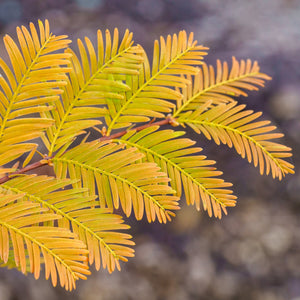
About
Metasequoia glyptostroboides, commonly called Dawn Redwood, is one of only three redwood species in the world. Unlike its evergreen cousins, the Coast Redwood (Sequoia sempervirens) and Giant Sequoia (Sequoiadendron giganteum), Dawn Redwood is a deciduous conifer—meaning it loses its soft, needle-like leaves in fall, offering brilliant autumn color before going dormant.
Discovered as a fossil and presumed extinct until a small grove was found in China in the 1940s, Metasequoia was introduced to the U.S. shortly after and has since become a valuable ornamental tree. It grows 50 to 100 feet tall in cultivation, with a spread of 20 to 30 feet, and can exceed those sizes in optimal conditions. Its rapid growth, straight trunk, and symmetrical, conical crown make it an excellent shade tree for large properties.
The Dawn Redwood’s needles are arranged in opposite pairs and are soft to the touch, turning warm shades of orange, copper, or golden brown in the fall. The trunk develops reddish-brown, vertically fissured bark that adds winter interest. Cultivars such as 'Gold Rush' (with bright golden foliage), 'Amber Glow' (orange-tinted growth), and 'Miss Grace' (a weeping form) offer additional variety for designers.
Redwoods thrive in moist, well-drained soil and tolerate a wide range of environmental conditions, including urban settings, clay soil, and periodic flooding. Their adaptability and stately presence make them a favorite for arboretums, college campuses, and gardens that can accommodate their size.
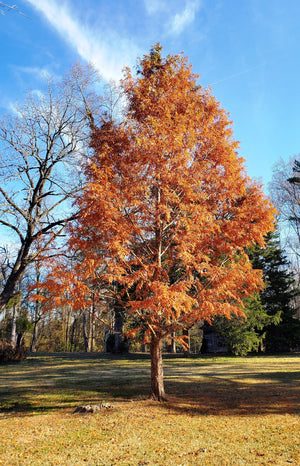
PLANTING
USDA Hardiness Zones: 5–8. Hardy in a wide range of climates across the eastern and central U.S.
Soil: Prefers deep, moist, well-drained soils. Tolerates clay, loam, and even periodic flooding. Avoid dry or sandy soils without supplemental watering.
Sunlight: Full sun is best for vigorous growth and strong branching. Tolerates light shade but may become sparse.
Watering: Keep soil consistently moist, especially when young. Mature trees tolerate occasional drought but prefer consistent moisture.
Spacing: Allow at least 25–30 feet from buildings or other large trees. Plant 10–20 feet apart for screens or groves.
Planting Time: Spring or fall is ideal to give roots time to establish before extreme temperatures.
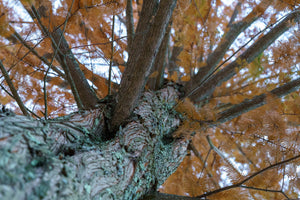
CARE
Watering: Regular, deep watering is important during the first 2–3 years. Once established, trees benefit from weekly watering during dry spells.
Fertilizing: Apply a balanced, slow-release fertilizer in early spring if growth appears weak or foliage pale. Most redwoods need little fertilization in good soil.
Pruning: Prune in winter to remove dead or damaged limbs and to shape the canopy if needed. Avoid removing the central leader. Weeping forms like 'Miss Grace' may need occasional training to maintain structure.
Pests and Diseases: Generally pest-free. Rarely affected by canker or leaf spot. Root rot can occur in poorly drained soils.
Mulching: Apply mulch around the base to retain soil moisture and regulate temperature. Keep mulch a few inches away from the trunk.
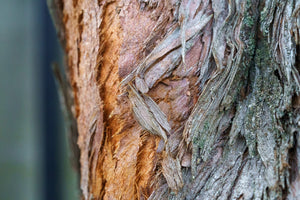
HOW TO USE
Focal Point: Use Dawn Redwood as a focal point in large lawns or at the terminus of long vistas. Its towering height, fall color, and winter bark texture provide year-round interest.
Shade Tree: Excellent for parks, schoolyards, and estates where fast shade is needed. The filtered light beneath allows for understory plantings.
Specimen Planting: Plant alone in a lawn or open space to showcase the tree’s full form. Cultivars like 'Amber Glow' and 'Gold Rush' provide bold color and unique foliage contrast.
Screen or Grove: Plant in groups for a naturalized grove effect or a fast-growing privacy screen. Dawn Redwood’s uniform habit creates an elegant, forested look.
Water Features and Low Areas: Ideal for planting near ponds or in areas with occasional flooding. Its tolerance for wet feet makes it suitable for rain gardens and riparian zones.
Large Border Backdrop: Use at the back of expansive beds to frame smaller flowering trees and shrubs like Dogwood, Viburnum, or Hydrangea.
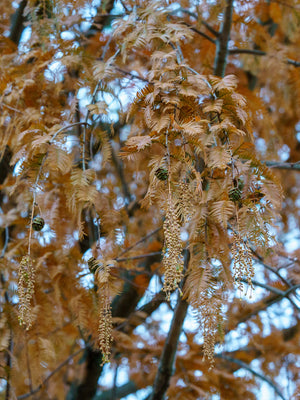
Common Questions
How tall are redwood trees? In cultivation, Dawn Redwoods typically reach 50–100 feet tall, with a spread of 20–30 feet. Wild specimens and ideal conditions can yield taller trees.
How long do redwoods live? Dawn Redwoods can live over 100 years, though many planted in the U.S. are still relatively young. Coast Redwoods and Giant Sequoias can live over 1,000 years.
Do redwoods only grow in California? The native Coast and Giant Redwoods are found in California, but Dawn Redwoods (Metasequoia glyptostroboides) grow well in many parts of the U.S., especially the East and Midwest.
How to plant a redwood? Choose a sunny site with rich, moist soil. Dig a hole twice as wide as the root ball, plant at the same depth, water thoroughly, and mulch to conserve moisture.
How to prune a redwood? Prune in late winter to remove damaged or poorly placed branches. Maintain a strong central leader and natural form.
How fast do redwoods grow? Dawn Redwoods grow quickly—2 to 3 feet per year under ideal conditions.
Do redwoods prefer full sun? Yes, full sun ensures dense growth and upright form. Trees in shade may grow more slowly and lean toward light.
Conclusion
Dawn Redwoods offer a majestic presence, fast growth, and historical intrigue. Their adaptability and ornamental value make them an outstanding choice for gardeners who have the space to accommodate their scale. Whether used as a focal point, grove, or living sculpture, redwoods bring structure and seasonal transformation to the landscape year after year.
The Redwood Collection
Sold Out

